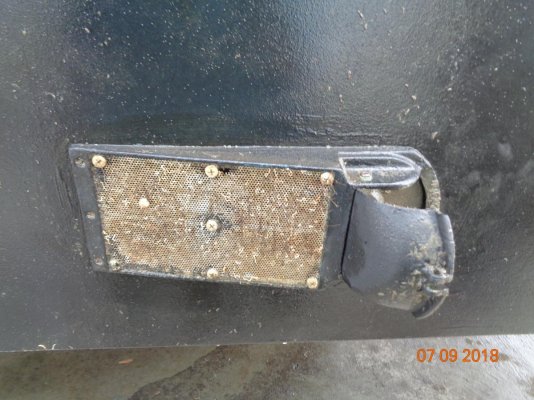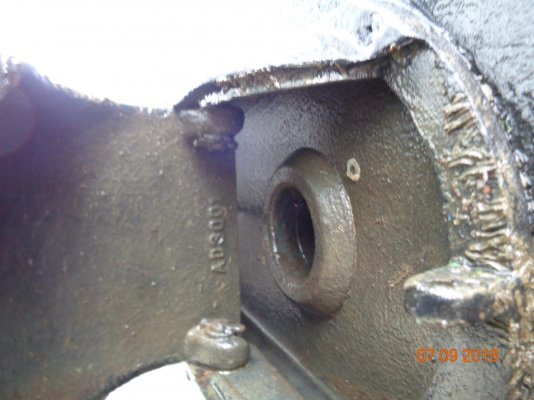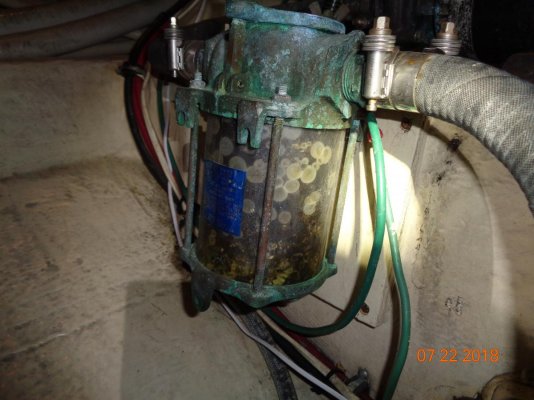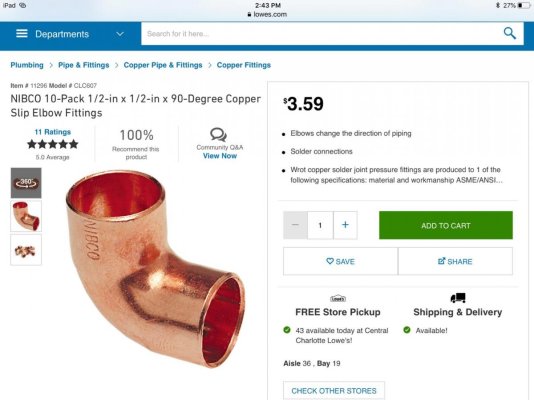I see a lot of fouled basket strainers on air-conditioning systems in Florida. Recently I encountered a boat with no basket strainer inside. Only a trap door screen type outside. I am posting the pics for comment. I have my own idea just want to see what others think...
You are using an out of date browser. It may not display this or other websites correctly.
You should upgrade or use an alternative browser.
You should upgrade or use an alternative browser.
Air-conditioner hull strainer outside only?
- Thread starter bglad
- Start date
The friendliest place on the web for anyone who enjoys boating.
If you have answers, please help by responding to the unanswered posts.
If you have answers, please help by responding to the unanswered posts.
LaBomba
Guru
- Joined
- Nov 18, 2012
- Messages
- 1,240
- Location
- Canada
- Vessel Name
- Looking Glass
- Vessel Make
- Carver 370 Voyager
Interesting, the boat we just purchased has these screens installed on her bottom but also has the internal basket strainers as well. It will work well here in the Trent canal as some lakes and parts of the canal system are extremely weedy. On ours they are on both the air conditioner systems as well as the raw water for the engine cooling, two different sizes.
caltexflanc
Guru
AKA South Bay strainers. I understand their use on propulsion engines of boats that get used a lot and regularly have the bottom cleaned. The flow of water underway sweeps them clean. You see them as OEM on high end sportfishers . I know people who swear by them. But I could never get my head around using them for a system that gets used when the boat is stationary.
HopCar
Guru
- Joined
- Aug 20, 2011
- Messages
- 5,308
- Vessel Name
- Possum
- Vessel Make
- Ellis 28
I installed one on Possum but I also left the internal strainer in place. After installing the Groco external strainer, I never had to clean the internal strainer.
I was worried about external fouling so I installed a larger external strainer than I really needed. With good bottom paint and an occasional visit from a diver, it wasn’t a problem. Yes I was careful not to plug the holes with paint.
This was on my engine cooling water intake.
My conclusion was, that with this type of external strainer, you don’t need an internal strainer. You do have to give some thought to external fouling, but if you have a diver cleaning the boat anyway, it’s not an issue.
I was worried about external fouling so I installed a larger external strainer than I really needed. With good bottom paint and an occasional visit from a diver, it wasn’t a problem. Yes I was careful not to plug the holes with paint.
This was on my engine cooling water intake.
My conclusion was, that with this type of external strainer, you don’t need an internal strainer. You do have to give some thought to external fouling, but if you have a diver cleaning the boat anyway, it’s not an issue.
Another pic
Attached is what most air-conditioner basket strainers look like that I see. It is also not unusual to find full grown critters in exterior scoop type strainers!
I was uncertain about using external screens on ACs and generators but the first photos I posted have me rethinking that idea. I am curious if others who have screen types on the hull exterior for air-conditioners report problems with excessive fouling between hull scrubbings?
Trap door type strainers are good because a diver can open them and reach inside when necessary and clean the thru-hull and strainer interior. Unless you have a sea chest you typically cannot do that from inside.
Attached is what most air-conditioner basket strainers look like that I see. It is also not unusual to find full grown critters in exterior scoop type strainers!
I was uncertain about using external screens on ACs and generators but the first photos I posted have me rethinking that idea. I am curious if others who have screen types on the hull exterior for air-conditioners report problems with excessive fouling between hull scrubbings?
Trap door type strainers are good because a diver can open them and reach inside when necessary and clean the thru-hull and strainer interior. Unless you have a sea chest you typically cannot do that from inside.
Attachments
stubones99
Guru
I think I would take the screen and have it copper plated so it would deter marine growth down here in warmer waters.
hmason
Guru
- Joined
- Aug 9, 2013
- Messages
- 2,764
- Location
- USA
- Vessel Name
- Lucky Lucky
- Vessel Make
- Pacific Mariner 65
We are spending the summer aboard in Stuart, FL. A couple of months ago I noted the AC overboard discharges (3) which run off one pump had slowed considerably. I pulled the sea strainer and found it to be pretty clean. After reinstalling it all was well. About a week later the same thing happened again. I dealt with this same issue a number of times. A clean strainer, limited water flow.
I reasoned
that perhaps something was getting trapped on the intake below the boat. I turned off the AC for a minute then turned it back on and got full flow again. This has worked perfectly every time since. I think shutting off the suction releases whatever is trapped below. I should point out that running 3 AC units with one pump keeps the pump running 24/7 in the FL heat so there is never a break in the suction.
I reasoned
that perhaps something was getting trapped on the intake below the boat. I turned off the AC for a minute then turned it back on and got full flow again. This has worked perfectly every time since. I think shutting off the suction releases whatever is trapped below. I should point out that running 3 AC units with one pump keeps the pump running 24/7 in the FL heat so there is never a break in the suction.
OldDan1943
Guru
- Joined
- Oct 2, 2017
- Messages
- 10,595
- Location
- USA
- Vessel Name
- Kinja
- Vessel Make
- American Tug 34 #116 2008
I reasoned
that perhaps something was getting trapped on the intake below the boat. I turned off the AC for a minute then turned it back on and got full flow again. This has worked perfectly every time since. I think shutting off the suction releases whatever is trapped below. I should point out that running 3 AC units with one pump keeps the pump running 24/7 in the FL heat so there is never a break in the suction.
2 possible solutions. Both happened to me.
Solution #2 I created a gadget from a spare strainer cover. Realize this is for maintenance and must be removed when not in use. Drill the spare cover, fit a garden hose connection, back flush from the strainer out through the hull inlet, after cleaning the strainer basket and reinstalling it. I use FW because I have FW spigot in the ER. I back-flush every time I clean the strainer. Remember to close and open the hull valve as necessary when back-flushing the basket through the hull inlet.
Solution 2 I would blow back through the the hull opening, the AC would run for a bit and then shut down on HP error. I back flushed repeatedly and for 3 or 4 minutes each time.... still it would shut down after a couple of minutes, HP.
Thinking it was a bigger problem, I called out a tech. Well, we talked it over.... he was closest the strainer and hull valve. I asked him to pull the hose off between hull valve and the strainer. He did, thinking it might be plugged up with sea creatures and knowing I had a spare length of hose.... I suggest he run a wooden dow through the hose..... He did and out popped a chewed up Publix plastic bag. Neither of us expected that. The Little Giant SW pump had sucked the bag thought the hull strainer and it lodged in the hose. "Reassembled in reverse order..." end of problem.
Last edited:
Bigsfish
Guru
- Joined
- Aug 29, 2016
- Messages
- 2,987
- Location
- USA
- Vessel Name
- Gotcha
- Vessel Make
- Grand Banks. Heritage. 54
I had a boat with Cat engines that the builder used external (commercial) strainers, only. In 21 years I never had a problem but the boat was used a minimum of once per week plus when swimming I would clean the strainers. Next boat had internal-strainers but I added the external strainers and it was problem fee u til I sold it. New boat has internal strainers and these are giving no problem but I will certainly add the external ones if these plug easily.
Warning, the external strainers are installed slanted so if you lose one engine and don’t close the tru hull it may force water into your engine.
Warning, the external strainers are installed slanted so if you lose one engine and don’t close the tru hull it may force water into your engine.
I was on a fishing expedition with this post. What I noticed about the first photos that caught my attention was almost zero growth inside the exterior hull strainer. The basket strainer photo posted in #8 quite another story (also different boat).
I wonder if the basket strainer is not just acting as a repository for the bugs who may be passing through possibly even trapped by it! The screened exterior strain seemed to keep almost everything out.
I wonder if the basket strainer is not just acting as a repository for the bugs who may be passing through possibly even trapped by it! The screened exterior strain seemed to keep almost everything out.
FF
Guru
- Joined
- Oct 12, 2007
- Messages
- 22,552
An external strainer would make cleaning off jelly fish at 3AM an adventure.
That is for sure but I think if it is large enough there would not be much suction to attract debris or critters. I am just theorizing at this point. Will eventually have an opportunity to test.
An external strainer would make cleaning off jelly fish at 3AM an adventure.
O C Diver
Guru
- Joined
- Dec 16, 2010
- Messages
- 12,867
- Location
- USA
- Vessel Name
- Slow Hand
- Vessel Make
- Cherubini Independence 45
This is the outside strainer I use on both my charter boat and trawler. The screen opening is 9" x 4".
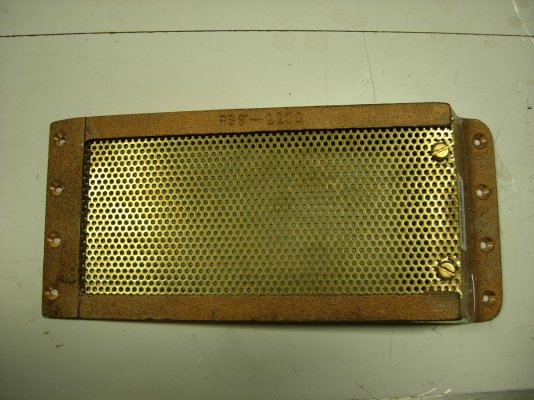
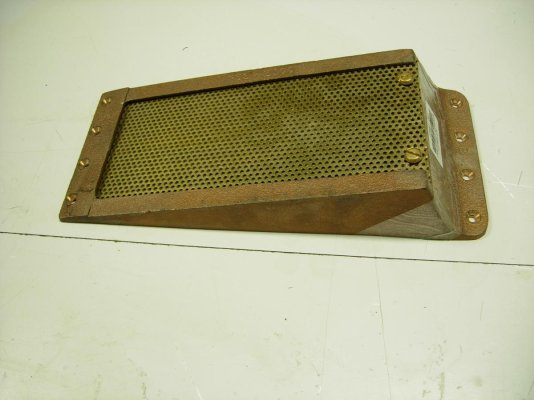
I get zero grass coming through it, which can be a big problem on Chesapeake Bay. The flat surface is so large that there isn't enough vacuum for debris to get pulled against it. The screen slides out after removing the 2 screws (replaced mine with 1/4" SS bolts). My diver can easily keep the screen clean with his bottom brush. Some of the watermen in the marina will remove the screen, bead blast it, and coat it with either Propspeed or the zinc spray paint. I still have strainer baskets on the inside of the boats as they came with them and I saw no disadvantage to keeping them.
I wouldn't own an in water boat without one. Now if you don't keep the boat bottom clean, I can see this getting covered with growth after a few months in Florida.
Ted


I get zero grass coming through it, which can be a big problem on Chesapeake Bay. The flat surface is so large that there isn't enough vacuum for debris to get pulled against it. The screen slides out after removing the 2 screws (replaced mine with 1/4" SS bolts). My diver can easily keep the screen clean with his bottom brush. Some of the watermen in the marina will remove the screen, bead blast it, and coat it with either Propspeed or the zinc spray paint. I still have strainer baskets on the inside of the boats as they came with them and I saw no disadvantage to keeping them.
I wouldn't own an in water boat without one. Now if you don't keep the boat bottom clean, I can see this getting covered with growth after a few months in Florida.
Ted
Hi Ted,
What system is this on (engines or other)? How often do you have to scrub your basket strainers with this setup?
Bill G.
What system is this on (engines or other)? How often do you have to scrub your basket strainers with this setup?
Bill G.
This is the outside strainer I use on both my charter boat and trawler. The screen opening is 9" x 4".
View attachment 79201
View attachment 79202
I get zero grass coming through it, which can be a big problem on Chesapeake Bay. The flat surface is so large that there isn't enough vacuum for debris to get pulled against it. The screen slides out after removing the 2 screws (replaced mine with 1/4" SS bolts). My diver can easily keep the screen clean with his bottom brush. Some of the watermen in the marina will remove the screen, bead blast it, and coat it with either Propspeed or the zinc spray paint. I still have strainer baskets on the inside of the boats as they came with them and I saw no disadvantage to keeping them.
I wouldn't own an in water boat without one. Now if you don't keep the boat bottom clean, I can see this getting covered with growth after a few months in Florida.
Ted
O C Diver
Guru
- Joined
- Dec 16, 2010
- Messages
- 12,867
- Location
- USA
- Vessel Name
- Slow Hand
- Vessel Make
- Cherubini Independence 45
Hi Ted,
What system is this on (engines or other)? How often do you have to scrub your basket strainers with this setup?
Bill G.
This strainer on my trawler covers a 2" seacock (it's rated for a 3" seacock). The seacock feeds a distribution box for the engine, generator, air conditioning pump, and salt water washdown pump. While the combine volume of all items is about 50 GPM, I rarely exceed 30 GPM. I did test it at full capacity though.
I clean the basket about every 3 or 4 months, but will try adding some copper to cut down the coral growth. In the fall through spring, I'll close the seacock for a couple of weeks at a time. The organisms deplete the water of oxygen and everything dies.
Ted
HopCar
Guru
- Joined
- Aug 20, 2011
- Messages
- 5,308
- Vessel Name
- Possum
- Vessel Make
- Ellis 28
This is the outside strainer I use on both my charter boat and trawler. The screen opening is 9" x 4".
View attachment 79201
View attachment 79202
I get zero grass coming through it, which can be a big problem on Chesapeake Bay. The flat surface is so large that there isn't enough vacuum for debris to get pulled against it. The screen slides out after removing the 2 screws (replaced mine with 1/4" SS bolts). My diver can easily keep the screen clean with his bottom brush. Some of the watermen in the marina will remove the screen, bead blast it, and coat it with either Propspeed or the zinc spray paint. I still have strainer baskets on the inside of the boats as they came with them and I saw no disadvantage to keeping them.
I wouldn't own an in water boat without one. Now if you don't keep the boat bottom clean, I can see this getting covered with growth after a few months in Florida.
Ted
Looks like a Buck Algonquin strainer.
Bigsfish
Guru
- Joined
- Aug 29, 2016
- Messages
- 2,987
- Location
- USA
- Vessel Name
- Gotcha
- Vessel Make
- Grand Banks. Heritage. 54
Senor FF, while I have never had a problem with jelly fish I did get a plastic bag to stickto the screen late at night. I closed the sea cock pulled the hose and took a water hose wrapped wit a cloth, turn on the hose and blew away the bag.
Ted, do you know the diameter of those holes? Is larger better than smaller? Mine appear to be 1/16”
Ted, do you know the diameter of those holes? Is larger better than smaller? Mine appear to be 1/16”
OldDan1943
Guru
- Joined
- Oct 2, 2017
- Messages
- 10,595
- Location
- USA
- Vessel Name
- Kinja
- Vessel Make
- American Tug 34 #116 2008

BTW. Ted has a sea chest. Lucky guy.
O C Diver
Guru
- Joined
- Dec 16, 2010
- Messages
- 12,867
- Location
- USA
- Vessel Name
- Slow Hand
- Vessel Make
- Cherubini Independence 45
Senor FF, while I have never had a problem with jelly fish I did get a plastic bag to stickto the screen late at night. I closed the sea cock pulled the hose and took a water hose wrapped wit a cloth, turn on the hose and blew away the bag.
Ted, do you know the diameter of those holes? Is larger better than smaller? Mine appear to be 1/16”
They don't list a hole size, but I'm guessing it's between 1/8 and 1/16". On mine, they list the surface area of the holes totaling 13 square inches. Since I also have an internal strainer basket, I would prefer 1/4" holes as I think they would be easier to clean with a divers scrub brush. Perforated stainless steel sheet metal comes in many hole sizes, so it would be easy to make another screen with bigger holes.The reality of the situation is that it's extremely unlikely that something is going to cover the whole surface. If it happens, it won't matter what size the holes are.
Have thought about adding a valve and hose connection to my distribution box so that I could flush some freshwater back through the system to dislodge a plastic bag from the surface of the external strainer.
Ted
Bigsfish
Guru
- Joined
- Aug 29, 2016
- Messages
- 2,987
- Location
- USA
- Vessel Name
- Gotcha
- Vessel Make
- Grand Banks. Heritage. 54
“Have thought about adding a valve and hose connection to my distribution box so that I could flush some freshwater back through the system to dislodge a plastic bag from the surface of the external strainer.”
That would require you having a valve you could close on all hoses that get their supply from the sea chest I would think.
That would require you having a valve you could close on all hoses that get their supply from the sea chest I would think.
O C Diver
Guru
- Joined
- Dec 16, 2010
- Messages
- 12,867
- Location
- USA
- Vessel Name
- Slow Hand
- Vessel Make
- Cherubini Independence 45
“Have thought about adding a valve and hose connection to my distribution box so that I could flush some freshwater back through the system to dislodge a plastic bag from the surface of the external strainer.”
That would require you having a valve you could close on all hoses that get their supply from the sea chest I would think.
All are valved except the main engine. The lift muffler has a drain. So it would be a simple matter to keep water from going back into the engine. More of an issue is not over pressurizing the plastic bowl on the strainer.
The main engine has a raw water loop maybe 18" above sea level. I'm thinking this is more about flow volume and less about pressure.
Ted
FF
Guru
- Joined
- Oct 12, 2007
- Messages
- 22,552
Bigger holes in the plate might be easier to clean BUT in shallow water where sand can swim , the smaller holes may be safer.
I am sure the fitting mfg sized the number of holes and their diameter to the discharge .
A stiff wire works well at pushing the holes back to like new size , BUT pushes the debris into the cooling circuit. A hose off flush might be wise.
I am sure the fitting mfg sized the number of holes and their diameter to the discharge .
A stiff wire works well at pushing the holes back to like new size , BUT pushes the debris into the cooling circuit. A hose off flush might be wise.
Shaunc
Veteran Member
My ex boat neighbor has developed this strainer. I have seen it work and its amazing, and I can say I have seen it work 1st hand. He says he will give me one to try out.
His theory behind this is that the strainer we all use has holes that are to small and as a result clog easily. That then causes water flow to slow down and that causes barnacles to grow and compounding the problem.etc etc.
This system keeps the water flow going and he does not clean the strainer regularly and I think he has gone months without cleaning it.
https://seasyclean.com/
His theory behind this is that the strainer we all use has holes that are to small and as a result clog easily. That then causes water flow to slow down and that causes barnacles to grow and compounding the problem.etc etc.
This system keeps the water flow going and he does not clean the strainer regularly and I think he has gone months without cleaning it.
https://seasyclean.com/

